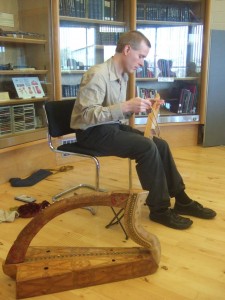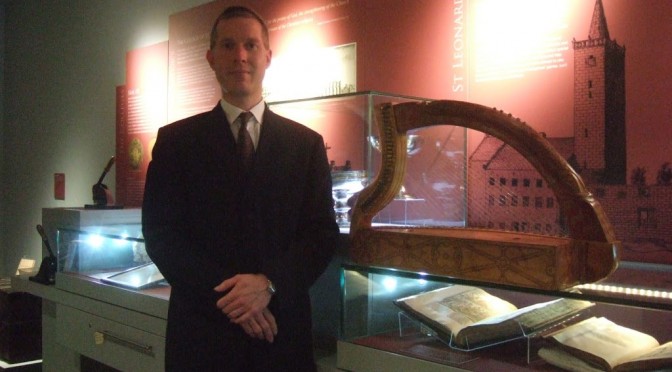Here’s a photo of me playing the jouhikko in my concert at lunchtime today in the Wighton Centre.
Category: concert
Margaret 1281 concert in Dundee
On Wednesday lunchtime I’ll be presenting my Margaret 1281 programme in the Wighton Centre, in Dundee Central Library. This is always a fun event, the free concert run by the Friends of Wighton on the first Wednesday of every month at 1.15pm.
I presented this programme back in June at St Andrews Cathedral and it worked very well. The idea is to present a dramatic episode of Scottish history in music and verse. All of the six items on the programme have strong connections to Scotland or Norway in the late 1200s and early 1300s.
As well as playing the replica Queen Mary harp, I’ll sing the traditional ballad telling a part of this story, and I’ll also pull out the jouhikko for a bit of old Scandinavian flavour.
Botanic garden photo from last night
Botanic Baroque
On Saturday evening I will be at the botanic gardens here in St Andrews for an outside evening concert. I’ll have my 18th century Irish harp with me and will be playing a programme of “Carolan, Connellan & Lyons”.
The Downhill harp is loud and strident enough to work in an outdoors setting, and I am hoping that the elegant and sweet tunes from these three composers will complement the summer evening picnic ambience on the lawn of the gardens.
I am interested in these three composers as the finest exponents of the “Irish baroque”, a kind of fusion of the old native styles with the fashionable Italianate music that swept into Scotland and Ireland in the years around 1700.
In Ireland it was the harpers who embraced this new fashion, and Carolan and Lyons were right in there composing Italianate tunes or variation sets in full-on continental style, though always viewed through the prism of the old Gaelic performance traditions on the early Gaelic harp. Connellan, being that bit earlier, worked in a more traditional way though he can perhaps be seen as one of the earliest to compose the big 18th century irish “sean-nos” songs.
In Scotland, the few harpers that remained by 1700 did not engage with this Italian music fashion, and it was the fiddlers who were the most enthusiastic in developing the Scottish baroque style. James Oswald is perhaps the best known and most prolific, and I am using his delightful setting on one of Lyons’s tunes. Lyons called it “Miss Hamilton” after one of his patrons, but Oswald calls it “The blossom of the rasberry” which wonderfully fits our Botanic Garden theme. There is a lovely variation in Oswald’s set which may have come from Lyons but really sounds more like Oswald’s work.
At the National Museum of Scotland this afternoon
Harp music in the National Museum of Scotland
I am playing two special events in the gallery beside the Queen Mary harp in the National Museum of Scotland, Chambers St. Edinburgh, as part of the 26 Treasures series. The Queen Mary harp is treasure no. 8, and Sara Sheridan is the writer who has been assigned this treasure.
On Saturday 3rd December 2011, I am playing at the launch event, in the gallery beside the Queen Mary harp, four 20 minute performances at 12.30, 1.30, 2.30 & 3.30pm.
And on Wednesday 14th December 2011, at 10.30am, I am working with Sara Sheridan to present a childrens’ storytelling event about the Queen Mary harp.
Upstairs in John Knox House last night
Cathedral recital
The next Cathedral recital is tomorrow, Tuesday 5th July, at 12.45pm
Medieval battle music in the ruins of St Andrews Cathedral.
The programme will be centred around the grand formal ceremonial tune, ‘The Battle of Harlaw’, celebrating the bloody fighting in Aberdeenshire six hundred years ago this month, in July 1411. Other highlights of the programme will be ‘Hei Tuti Teti’, reputedly Robert the Bruce’s march, and later used by Robert Burns for his song ‘Scots Wha Hae’. I will also recite some verses from the Gododdin, “Scotland’s oldest poem”, which describes the defeat of the men of Edinburgh in a battle in around 600AD – over one thousand four hundred years ago.
This event is part of my summer series of medieval harp concerts in the cathedral. Performed in the Priors House, a medieval vaulted chamber set within the ruins of the Cathedral in St Andrews, this series brings to life different aspects of ancient and historical Scottish music.
The last concert, in June, focussed on medieval church music and included pieces from the ‘St Andrews Music Book’ – a medieval manuscript compiled and written in St Andrews in the 13th century, which is now preserved in a library in Germany. For August, I will play grand Gaelic laments, weeping for the fallen and commemorating great chieftains and warriors. But this next recital on 5th July will draw together tunes from very disparate sources to paint a picture of the ceremonial and martial music of court and castle in medieval Scotland.
The harp I use is a unique replica of the clarsach of Mary Queen of Scots. The 500-year-old original is preserved in a glass case in the National Museum of Scotland in Edinburgh. I commissioned my replica from Irish harp maker Davy Patton in 2006-7. With its amazing soundbox carved out of a single huge willow log, and its intricate carved and painted decoration, the replica harp is a precious medieval art object that fits very well into the ancient ambience of the cathedral.
Admission is free. Tickets can be reserved in advance by calling the Cathedral visitor centre on 01334 472563.
Blind and partially sighted
 Today I presented a lunchtime talk for the Museum of the University of St Andrews, in their medieval gallery. The talk was to present and describe and demonstrate the replica Queen Mary harp. The medieval gallery of the museum holds some very interesting early treasures of the university, including its three exquisite silver-gilt 15th century maces. However these were not in their display case today, as they are being paraded up and down the streets of St Andrews during the Graduation processions.
Today I presented a lunchtime talk for the Museum of the University of St Andrews, in their medieval gallery. The talk was to present and describe and demonstrate the replica Queen Mary harp. The medieval gallery of the museum holds some very interesting early treasures of the university, including its three exquisite silver-gilt 15th century maces. However these were not in their display case today, as they are being paraded up and down the streets of St Andrews during the Graduation processions.
Before the talk proper, there was a special session for blind and partially sighted people. The museum staff had prepared a special “audio description” of the harp, and embossed line drawings of it, and the blind and partially sighted attendees also had lots of opportunity to touch and feel the carving and decoration on the harp.
For the talk itself I concentrated on the ceremonial music of the old harp traditions. I tried to tie the discussion in with the objects on display; “Gosteg yr Halen” from the Robert ap Huw manuscript went with a 16th century silver salt cellar; I read a translation from George Buchanan’s history of Scotland, a first edition of which is on display in the gallery; and we compared both the decoration on the harp as well as the structure of the music with a carved Pictish cross slab that stands in the museum.
Finally, to tie in with the 600th anniversary of the founding of the University, in 1411, I played a piece of music for another 600th anniversary: “the Battle of Harlaw”, which commemorates and describes this famous and bloody battle which was fought in Aberdeenshire in July 1411.











